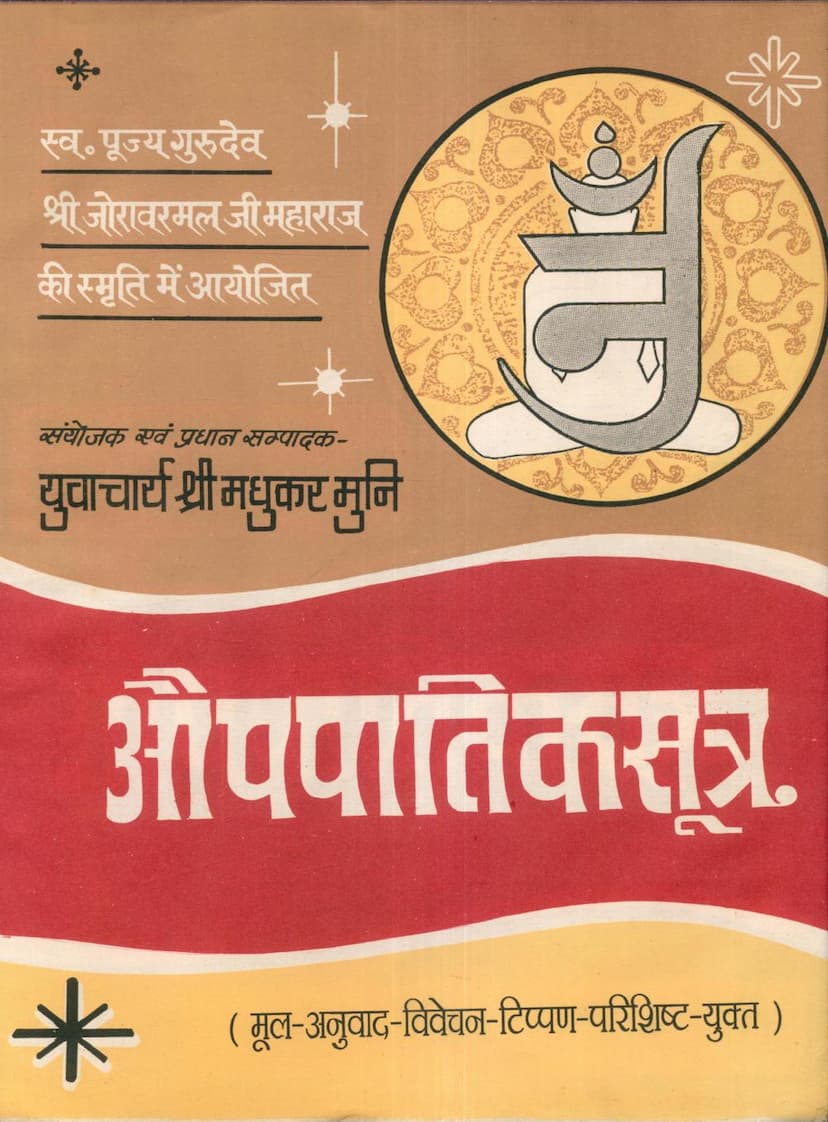Agam 12 Upang 01 Auppatik Sutra Stahanakvasi
Added to library: September 1, 2025

Summary
Here is a comprehensive summary of the Jain text, the Aupapātik Sūtra, based on the provided pages:
Title: Aupapātik Sūtra (औपपातिकसूत्र)
Series: Jināgama Granthamālā (जिनागम-ग्रन्थमाला), Publication No. 13
Authors/Contributors:
- Conceived and guided by: Yuvāchārya Shri Mishrimalji Maharaj 'Madhukar' (संयोजक तथा आद्य सम्पादक (स्व.) युवाचार्य श्री मिश्रीमलजी महाराज 'मधुकर')
- Editor/Translator/Annotator: Dr. Chhaganlal Shastri, Kāvyatīrth, M.A., Ph.D., Vidyamahodadhi (अनुवादक-विवेचक डा. छगनलाल शास्त्री, काव्यतीर्थ एम.ए., पी.एच.डी., विद्यामहोदधि)
- Contributing Editors: Muni Shri Kanhaiyalal 'Kamal' (अनुयोग प्रवर्तक मुनि श्री कन्हैयालाल 'कमल'), Āchārya Shri Devendra Muni Shastri (आचार्य श्री देवेन्द्रमुनि शास्त्री), Shri Ratan Muni (श्री रतनमुनि)
- Direction: Sadhwi Shri Umrav Kunwar 'Archana' (निर्देशन साध्वी श्री उमरावकुंवर जी म.सा. 'अर्चना')
- Inspiring Soul: Upapravartaka Shāsanasevī (Late) Swami Sri Brijlalji Maharaj (प्रेरणा उपप्रवर्तक शासनसेवी स्व. स्वामी श्री ब्रजलालजी महाराज)
- In Memory of: Swargiya Pujya Gurudev Shri Joravarmalji Maharaj (स्व.पूज्यगुरुदेव श्री जोरावरमलजीमहाराज की स्मृति में) and Mahāmanā, Mahān Shruta-sevī Āchāryavarya Shri Dharmasinghji Maharaj (आचार्यवर्य श्री धर्मसिंहजी महाराज की पुण्य स्मृति में).
Publisher: Shri Āgam Prakashan Samiti, Beawar (Rajasthan) (श्री आगमप्रकाशन समिति, ब्यावर (राजस्थान))
Edition and Publication: Third Edition, Vir-Nirvana Samvat 2526 / Vikram Samvat 2057, May 2000.
Core Content and Significance:
The Aupapātik Sūtra is presented as the First Upāṅga (first subsidiary text) to the Anga Āgama, Āchārānga Sūtra. Despite being an Upānga, it holds a unique and crucial position.
-
Structure: The Sūtra is divided into two main parts:
- First Half (Pūrvārdha): This section is primarily narrative-driven (कथाप्रधान). The descriptions contained within are considered supplementary to the main Anga Āgamas. The Sūtra often refers to a 'Vaṇṇao' (वर्णणओ) which indicates that the descriptions of cities, sacred groves (chaityas), forests, kings, queens, ascetics, etc., mentioned in other Āgamas should be understood according to the descriptions provided in the Aupapātik Sūtra. The prose is rich in rhetoric and elegant language, allowing the reader to deeply experience the reality of the descriptions. The publication emphasizes that the study of other narrative Sūtras remains incomplete without the study of this text.
- Second Half (Uttarārdha): This part details various traditions of ascetics and mendicants (परिव्राजक) representing different philosophical and religious viewpoints prevalent in ancient India. This section is noted as being significantly helpful for scholars and researchers of India's religious and cultural history.
-
Literary and Historical Value: The Aupapātik Sūtra is recognized as both a literary masterpiece and a historical document of various religious traditions and practices in ancient India. It can serve as a valuable guide for those chronicling the glorious saga of ancient India.
-
Thematic Focus: The Sūtra's name, "Aupapātik," is derived from the concept of "Upapāta" (उपपात), which refers to the birth and eventual spiritual attainment (Siddhi-gati) of divine beings and hell-dwellers. The commentary highlights that the Sūtra elucidates the nature of these births and destinations.
-
Detailed Descriptions: The text provides vivid and detailed descriptions of:
- Champā Nagari (चम्पा नगरी): The capital city of Anga, its grandeur, defenses, markets, inhabitants, and cultural vibrancy are meticulously described.
- Pūrṇabhadra Chaitya (पूर्णभद्र चैत्य): A detailed account of this sacred site, its adornments, the presence of various performers, and its significance as a place of worship.
- Forests and Flora (वनखण्ड, पादप): The rich description of the natural environment, including the Ashok tree and various other species of trees and plants, paints a picture of the lush landscape.
- King Kuṇika (कूणिक राजा): The text extensively details King Kuṇika's character, his devotion to Lord Mahāvīra, his administration, his queens (like Dhāriṇī), and his court. It also delves into the debate about whether Kuṇika was a Jain or Buddhist follower, strongly suggesting a Jain affiliation based on the textual evidence.
- Ascetic Traditions (परिव्राजक): The second half extensively catalogs various ascetic sects and their practices, offering a glimpse into the diverse religious landscape of ancient India. This includes detailed lists and descriptions of Brahmins, Kshatriyas, and other groups like the Ājīvakas, and various renunciate practices (tapas).
- Tapas (तप): The Sūtra describes numerous forms of ascetic practices, including detailed explanations of various types of fasts and disciplined austerities like Kanakāvalī, Ekāvalī, Simhaniskrīḍita, and Pratimas.
- Bhagavan Mahāvīra: The text describes Lord Mahāvīra's presence, his teachings, and his interactions with the community, including King Kuṇika. It also mentions the presence of various celestial beings and the profound impact of his teachings.
- The Concept of Siddha: The Sūtra concludes with a description of the liberated souls (Siddhas), their nature, location in the universe, and the unimaginable bliss they experience.
-
Language and Style: The language is classical Prakrit, with the first chapter's language being more complex and dense, while the latter part becomes simpler and more accessible. The text is rich in comparisons and descriptive adjectives.
-
Editorial Approach: This edition aims to provide a pure original text, a clear Hindi translation, and essential notes and annotations to make the Sūtra accessible to the modern reader. The publication is dedicated to preserving and propagating the Agamic literature, fulfilling a long-felt need.
In essence, the Aupapātik Sūtra, as presented in this volume, is a foundational Jain text that serves as a vivid narrative and historical repository. It illuminates the detailed descriptions of ancient Indian life, religious practices, philosophical schools, and the profound teachings of Lord Mahāvīra, making it indispensable for understanding the broader context of Jain Āgamic literature.